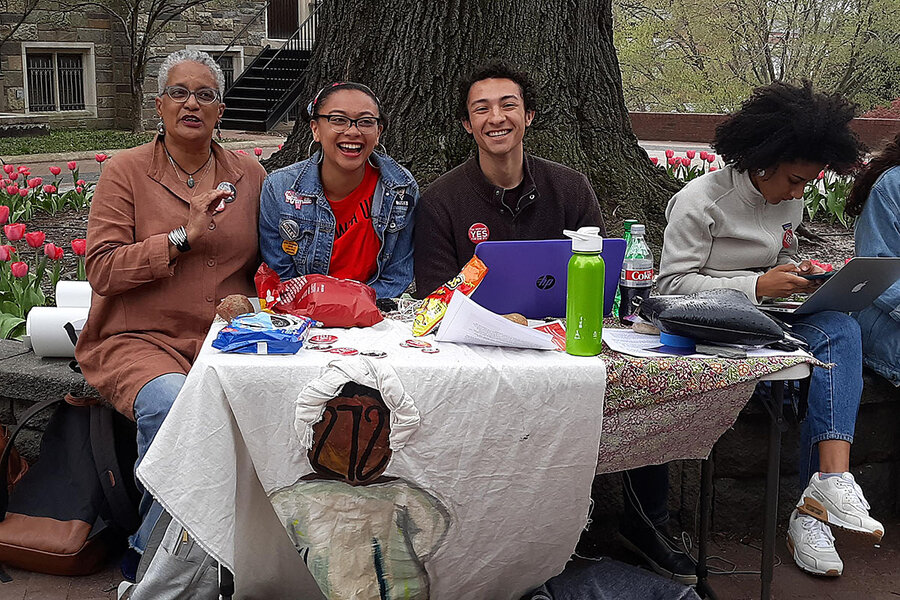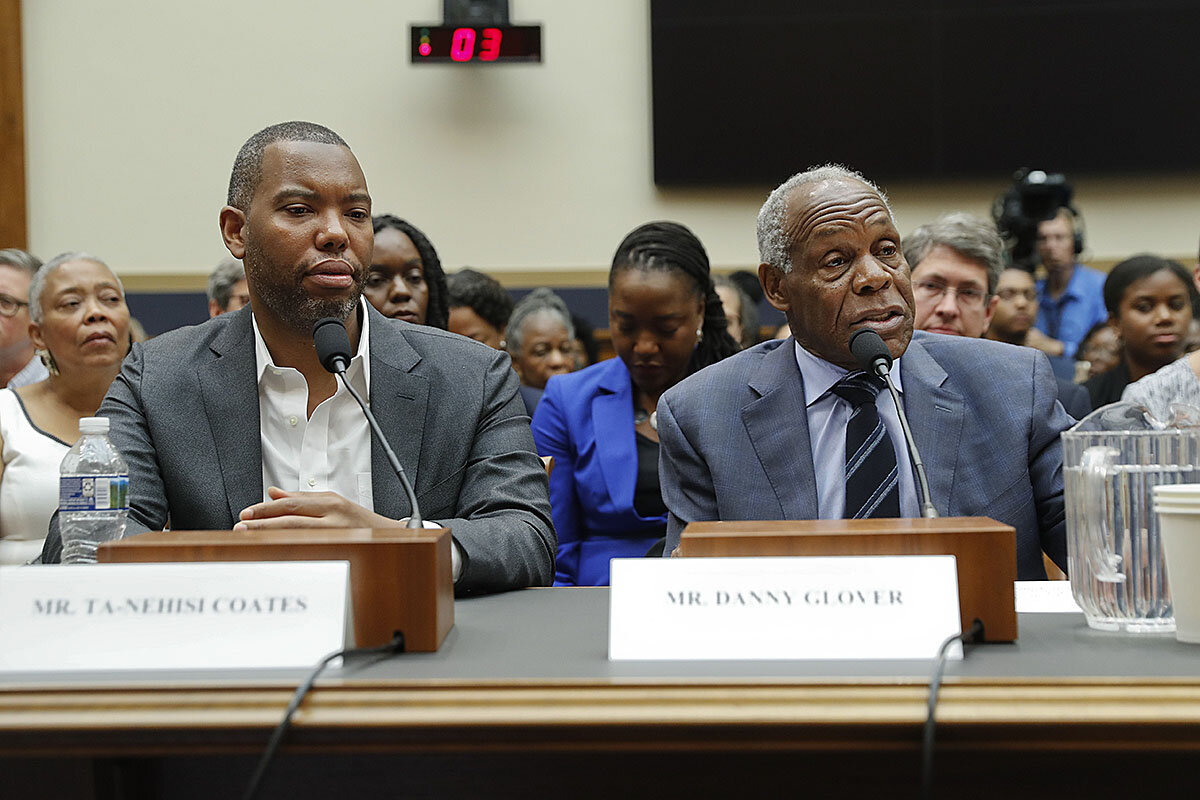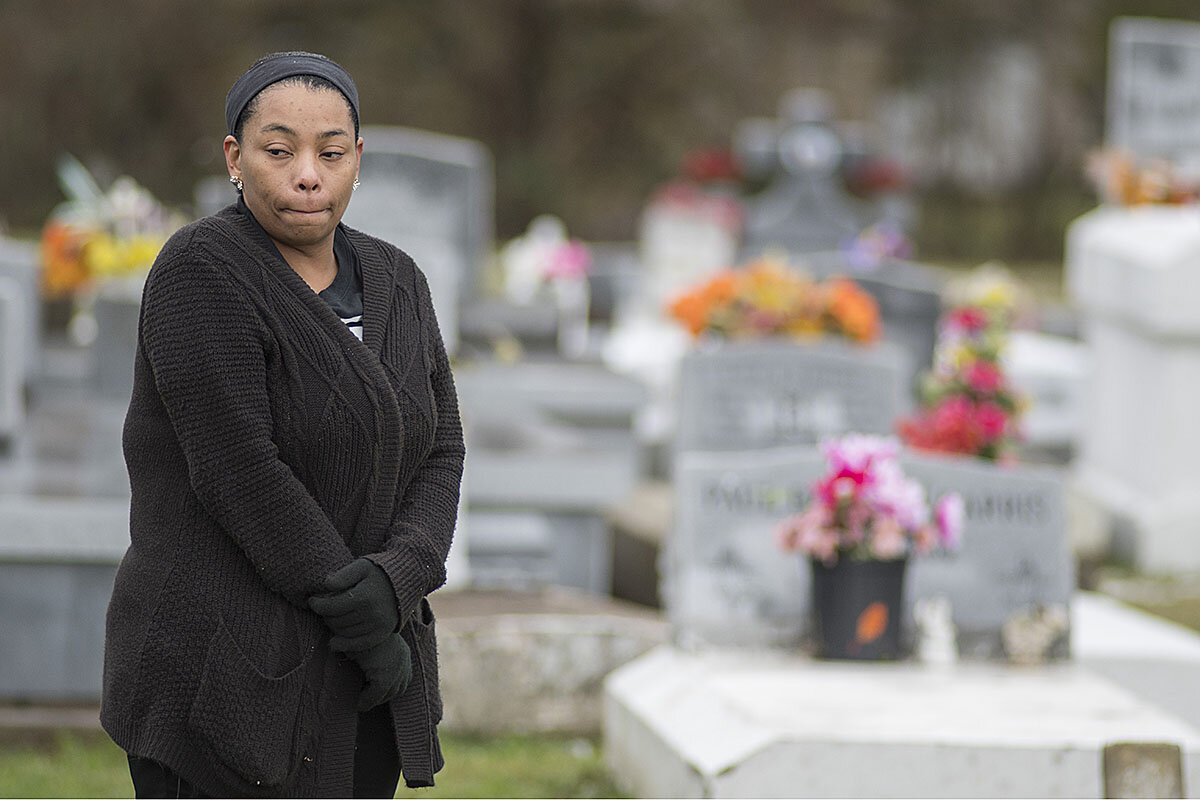Dollars today for enslavement long ago? Georgetown students say yes.
Loading...
They aren’t just a list of enslaved people. They have stories, and descendants, and names: Polly, Revidy, Noble, Minty, Mary Jane, Michael, Sally Anne.
Buttons bearing these names were worn by “vote yes” students as they campaigned at Georgetown University this spring. They wanted undergraduates to pay a “reconciliation contribution” of $27.20 each semester. The funds would benefit descendants of people enslaved by Maryland Jesuits, including the “GU272” – a group sold in 1838 to help keep Georgetown afloat.
At this elite university in the capital of the United States, the invisibility cloak that shrouds institutional entanglement with slavery has been stripped away. In the wake of student and alumni pressure, college and Jesuit leaders have renamed campus buildings, participated in ceremonial repentance, and offered legacy admission preferences to descendants.
Why We Wrote This
As the national dialogue over “reparations” heats up, some say financial support for projects that help descendants of slavery is one way to start a much longer journey of racial reconciliation.
But four years of slowly evolving dialogue can try the patience of students seeking bold action. So Georgetown’s undergraduates made their own history in April, with a two-thirds majority vote in favor of the referendum.
Although many American universities exploited slaves, “this is the first time we’ve seen a particular group taking the responsibility – not only with an apology, not only with a symbolic gesture, but by taking financial responsibility,” says Ana Lucia Araujo, a Howard University history professor who has researched the public memory of the slave trade.
The story of what happened before the vote – and what hasn’t happened since (namely, any commitment from Georgetown officials to implement the non-binding referendum) – is a parable of sorts about a nation wrestling with inhumanity at its very foundation.
Even the word “reparations” – popping up most recently thanks to a bill in Congress and the Democratic presidential primary race – carries a wide range of definitions. Where people stand on the matter can’t be assumed based on skin color or their own family history related to slavery. A House Judiciary subcommittee held a hearing on HR40, a bill that would set up a commission to study and recommend reparations proposals, on Wednesday morning.
The hearing coincides with Juneteenth, a day that since 1865 has commemorated the end of the enslavement of black people in the United States. Supporters of the bill, including actor Danny Glover and writer Ta-Nehisi Coates, were among those who testified, alongside those who oppose it, such as writer Coleman Hughes.
“[W]hile emancipation deadbolted the door against the bandits of America, Jim Crow wedged the windows wide open,” said Mr. Coates. “The matter of reparations is one of making amends, indirect redress. But it also a question of citizenship,” he said, urging lawmakers to “reject fair-weather patriotism, to say that a nation is both its credits and its debits, that if Thomas Jefferson matters, so does Sally Hemings. ... The question really is not whether we will be tied to the somethings of our past but whether we are courageous enough to be tied to the whole of them.”
Georgetown’s experience is one part of a national dialogue that’s still finding its way, with some Americans saying it’s time to push for long overdue justice while others argue to let bygones be bygones.
Shift in thought
The campus town hall event in April was packed. When Javon Price saw that everyone vocally opposing the referendum was white, he stood to add his voice: “As a black student, why should I have to contribute to this reconciliation fee? I don’t see how that makes sense,” he recalls saying at the forum.
A conservative Republican who had recently returned from a tour with the Air Force Reserve, he had been working to get fellow students to vote no.
Right in front of him sat Mélisande Short-Colomb, a descendant who had taken the school up on its invitation to apply for admission with a legacy preference.
Her answer: “We all come to Georgetown University, including myself today, voluntarily … believing that there is something here for each of us to receive” and leverage to help others. Ms. Short-Colomb recounts: In 1838, people “were gathered up and they were sold to the deepest, most racist concentrated labor camps. ... They didn’t volunteer. ... This place exists today because of them.”
Mr. Price sat down.
“At that moment, I kinda just shut my mouth and allowed myself to receive the information that I had been rejecting,” he says. “When she speaks, there’s this gravitas. ... For a moment it felt as if my grandmother was speaking to me,” he says of the 65-year-old Ms. Short-Colomb, who can trace her lineage to two GU272 families, the Queens and the Mahoneys.
He voted yes. The word “reparations” is still problematic in his view, Mr. Price says, partly because it implies giving a one-time payment and being done.
But as he came to understand this student-generated effort, the word they used – reconciliation – was indeed a better fit.
The intent is for a group of student and descendant representatives to consider proposals that would benefit descendant communities with the roughly $400,000 to be raised each year.
“Reconciliation is a process, a marathon; it’s not a sprint,” he says.
Plenty of Georgetown students still objected. Some argued that none of them were slaves or owned slaves, so none should be forced to pay more on top of already steep fees. Others favored a financial commitment, but felt strongly that the university should commit the dollars, not the students.
Who should decide?
Even among the descendants, there’s no consensus about what form, if any, reparations or reconciliation should take.
Jessica Tilson – a descendant who lives in Baton Rouge, Louisiana – raised multiple objections. She thought the student advocates should have polled the 4,000-plus descendants, rather than letting the few who are Georgetown students hold sway.
When the advocates said they’d consider directing money toward things like boosting education or internet access for descendant communities like Maringouin, Louisiana, where Ms. Tilson has roots – they “made us look like country bumpkins,” she says.
She told them, “What do you mean you are more privileged than me?... You’re going to have student loan debt just like me,” says Ms. Tilson, who earned a bachelor’s degree from Southern University and A&M College.
She especially disagreed with students being forced to pay, saying she would never want to receive something that wasn’t given willingly. She says she told some of the on-campus descendants, “Y’all guilt-tripping those white kids there.”
But some supporters of the referendum say it purposely avoided the narrative of shame.
“This is not being framed as a matter of collective guilt. This is being framed as an act of collective generosity,” says Richard Cellini, an alumnus and founder of The Georgetown Memory Project, the nonprofit that has helped identify 8,425 descendants, half of whom are still living.
It’s really an expression of gratitude, he says. The students are “saying of the Georgetown slaves: Their story is our story, and we want to share our resources with the families that made our university possible.”
Awaiting approval
The collection of the $27.20 fee won’t happen without approval from Georgetown’s board of directors, which has met with some student leaders but did not vote on the reconciliation fee at its June 5-6 meeting.
“Georgetown University values the perspectives and engagement of our students in grappling with the history and ongoing legacy of slavery in our community,” spokesperson Meghan Dubyak said in an email to the Monitor. “We are working to contribute to a vital national conversation about the need to promote racial justice. ... The referendum provides valuable insight into student perspectives.”
The board is planning more discussions and will meet again this fall, she added.
If the Georgetown administration doesn’t implement the students’ plan, “it would be an abdication of responsibility on an historic scale,” Mr. Cellini says.
Ms. Short-Colomb became a student at Georgetown in August 2017, just one year after discovering that her ancestors had been part of the 1838 sale.
Since her own family had been among “the involuntary founders of Georgetown University, who have been left out of the history,” she wanted to understand the institution up close. “I went out on a big limb for myself … and I think the administration went out on a limb with me as well. ... It’s been wonderful,” she says.
After the highest voter turnout in student government history, the results of the April 11 vote were announced online around 1 a.m. A giddy phone call from her fellow student advocates awoke Ms. Short-Colomb. They said they were coming over to celebrate, “and I said, ‘No, no, no. Thank you. I love you all. Goodnight, I’m going back to sleep,’” she says.
She laughs about it now, but as the news sank in that morning, she says, “I cried a little bit. I thanked the ancestors. Because this is really for them, you know?”








